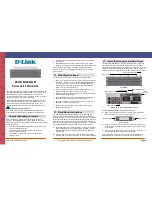
Chapter 2
Installing the Device
RUGGEDCOM RSL910
Installation Guide
12
Connecting High AC/DC Power
IMPORTANT!
Siemens requires the use of external surge protection in VDSL applications where the line may be
subject to surges greater than that for which the device is rated. Use the following specifications as a
guide for VDSL external surge protection:
• Clamping Voltage: 50 V to 200 V
• Insertion Loss: < 0.1 dB at 10 MHz
• Peak Surge Current: 10 kA, 8x20µs waveform
CONTENTS
•
Section 2.5.1, “Connecting High AC/DC Power”
•
Section 2.5.2, “Connecting Low DC Power”
Section 2.5.1
Connecting High AC/DC Power
To connect a high AC/DC power supply to the device, do the following:
CAUTION!
Electrical hazard – risk of damage to equipment. Do not connect AC power cables to terminals for DC
power. Damage to the power supply may occur.
CAUTION!
Electrical hazard – risk of damage to equipment. Before testing the dielectric strength (HIPOT) in the
field, remove the braided ground cable connected to the surge ground terminal and chassis ground.
This cable connects transient suppression circuitry to chassis ground and must be removed in order to
avoid damage to transient suppression circuitry during testing.
NOTE
Torque all terminal connections to 0.6 N·m (5 lbf-in).
1. Secure the power terminal block to the device.
2. Connect the positive wire from the power source to the positive/live (+/L) terminal on the terminal block.
Summary of Contents for RUGGEDCOM RSL910
Page 4: ...RUGGEDCOM RSL910 Installation Guide iv ...
Page 10: ...Preface RUGGEDCOM RSL910 Installation Guide x Customer Support ...
Page 16: ...Chapter 1 Introduction RUGGEDCOM RSL910 Installation Guide 6 Supported Fiber Optic Cables ...
Page 30: ...Chapter 3 Device Management RUGGEDCOM RSL910 Installation Guide 20 Configuring the Device ...
Page 38: ...Chapter 4 Communication Ports RUGGEDCOM RSL910 Installation Guide 28 SFP Transceivers ...
















































